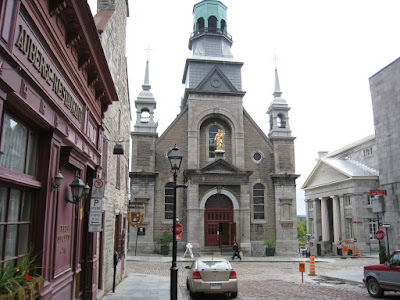Through the 1700's and 1800's the Old Town thrived, but the spread of the city North gradually pulled the commerce out of the historic district eventually leaving an abandonded semi-derelict neighbourhood by the mid 1900's. In 1960 the documented population for Montreal Old Town was less then 200 people. In 1962 Montreal City Planners announced a scheme to tear down the Old Town and build a new elevated expressway along the waterfront. Thankfully, protestors were successful in renegotiating the scheme to push the expressway several blocks North and underground when near the Old Town. This proved to be a turning point for the historic district which has seen renewed enthusiasm with the old buildings restored and a flourishing tourism based economy.
As you walk from the 'new' downtown towards the old you see the transition, with neither particularly new nor old Victorian blocks in between. Here the Victorian office buildings are dominated by the higher new towers behind them


The older buildings with new owners don't entirely shake off their roots.....this building at 100 Rue McGill was built in 1877 for the Hudsons Bay Company and their company name is still inscribed at the top. However, it's now a Van Houtte Coffee Shop with a Bank of Montreal ATM machine !

Also on Rue McGill is Montreals Customs House, built for the Goverment in 1912 and still occupied by them and the same department.

Now well into the Old Town is Place d'Armes. The 'Market Square' or heart of the Old Town it has staged military events, markets and was laid out as a formal garden during Victorian times. It was restored in the 1960's and it's current layout of monument and fountain in the centre adopted.

The South side of Place d'Armes is anchored by the Notre Dame Basilica. A Notre Dame church has been on this site since 1657 but the current building was constructed in 1830 when the original church became too small and had to be replaced. At the time of it's construction it was the largest church in North America.

Here is a short piece of footage of the bells ringing in Notre Dame and of Place d'Armes.
This is a statue of Paul Chomedey de Mainsonneuve in the centre of Place d'Armes, to commemorate a battle he fought & won on this site in 1644, and he is widely heralded as being responsible for establishing Montreal as a city.

The North West corner of Place d'Armes is marked by one of the first head offices for the Bank of Montreal, and still a premises owned by them. The Bank was established in 1817 and this building was built for them in 1859 when the Old Town was still the bustling financial centre of the city.

Further East in the Old Town on Rue Ste Paul is another church the Notre Dame de Bonsecours. This smaller church was built in 1771, but contains a statue of the Virgin Mary dating back to 1657 and was originally housed in the church previously on this site. This church is more commonly known as Eglise des Matelots (Sailor's Church) as locals would come here to pray for a safe passage if they were travelling, or to give thanks for one if they had just arrived in the City. The building in the corner on the left hand side with the red windows is Hotel Pierre du Calvet, the oldest hotel in the city dating back to 1725 and named after a justice of the peace for the city in the mid 1700's.

This is a large statue on the roof of the Notre Dame de Bonsecours overlooking the Old Port to the rear.

This is the Hotel Pierre du Calvet on the corner and a view East along Rue Ste Paul

The view West along Rue Ste Paul

This building was the home of Sir George Etienne-Cartier who was a French-Canadian stateman famed for forming a very successul Anglo-French coalition government in the mid 1800's. He was known to have negotiated with the Hudsons Bay Company to buy the land that is now the North West Territory, he lead establishment of the Provinces of British Columbia and Manitoba and created the Canadian Pacific Railway.

There are stong French influences in the architecture of many buildings in Montreal.

Also on Rue Ste Paul (original the main throughfare before development moved North and West) is Marche Bonsecours. This building not only served as the citys main market receiving goods from the Port directly behind it but it was also a sought after location for balls and galas and even served as City Hall for 25 years. It is no longer a functioning market in the traditional sense, but is home to boutique and other small upscale stores similar to Covent Garden for example. However, it is still a beautiful piece of architecture.


Viewed across the water from Bassin Bonsecours

Finally, on the edge of the Old Town waterfront these two buildings caught my eye. The one of the right, 333 Rue de la Commune Ouest was built in 1858 for a shipping company. There is a marker on the right hand side of the entryway (not visible in the photo) which marks the high point of the massive 1886 flood. The high point is about halfway up the ground floor windows.

While the largest of the buildings in the Old Town are largely restored for tourist appreciation, you still have a sense that this neighbourhood of Montreal is thriving, old warehouses turned into plush loft apartments and trendy offices. It may be graphic designers and successful artisans that now reside in the area rather than stock brokers or bank managers but nonetheless it is obviously once-again an affluent and bustling community.
No comments:
Post a Comment